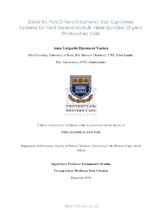| dc.description.abstract | Introduction: Tuberculosis (TB) is a serious bacterial infections caused by the Mycobacterium Tuberculosis (MTB) organism affecting mainly the lungs. Occasionally, MTB bacilli may be transported out of the pulmonary region and infect peripheral organs causing extra-pulmonary tuberculosis. Many therapeutic agents were developed over the years to combat TB, however the rapid emergence of resistant strains hampered their use. Furthermore, most of the current anti-TB drugs experience many challenges, which can be summarized in treatment regimen factors, drug-drug interactions, and physicochemical characteristics factors (such as hydrophobicity and low permeability into alveolar macrophages). These challenges have a significant role in treatment failure and the emergence of resistant TB. Due to the lack of newly discovered anti-TB drugs, and the absence of effective vaccines, many scientists have suggested the use of novel modalities for the current anti-TB drugs to enhance their efficacy and overcome some of the drawbacks. One of these modalities is nanotechnology-based drug delivery systems. Most of the anti-TB drugs experience low drug distribution to the lung and particularly alveolar macrophages within which the MTB resides, leading to treatment failure. Employing nanoparticles as drug delivery systems can have a significant impact on improving the pharmacokinetic profile of anti-TB drugs, the feasibility of different routes of administration, enhancing drug permeability, controlled/sustained drug release, and targeting specific disease sites. Collectively, these impacts will aid in enhancing drug concentration at the site of infection and reduce dosing and regimen duration. Dendrimers, such as polyamidoamine (PAMAM) dendrimers, are synthetic polymeric nanoparticles that have unique features that afford a dendrimer-conjugate complex the possibility to overcome the most common hurdles associated with drug delivery and treatment of diseases. Obstacles associated with solubility, permeability, inadequate biodistribution associated side effects may be enhanced. Manipulating the outermost surface functional groups with various ligands and polymers, will enhance the dendrimer properties and targeting potential. Aim: This study aims to develop a novel pulmonary delivery system for the anti-TB drug rifampicin using surface-modified G4 PAMAM dendrimer nanoparticles (polyethylene glycol (PEG) or mannose moieties), to improve drug solubility, prolong-release, enhance permeability into the macrophages, and decrease the toxicity of the drug-dendrimer conjugates. Methods: PAMAM dendrimers having increasing concentrations of poly(ethylene glycol) (PEG) 2 kDa or mannose residues were synthesized. The 4-nitrophenyl chloroformate was used as an activator in the case of PEG functionalization, while for the mannose conjugation the 4-isothiocyanatophenyl alpha-D-mannopyranoside (4-ICPMP) directly interacted with the primary amines of the dendrimer. The conjugated PEG polymers and mannose moieties on the dendrimer periphery were confirmed using FTIR and 1H NMR analytical techniques. Thereafter, rifampicin was loaded into the native and surface-modified dendrimers via a simple dissolution solvent evaporation method. Rifampicin-loaded dendrimers were then characterized using several analytical techniques namely; FTIR, DSC, NMR, SEM, and DLS. The polymer encapsulation efficiency (EE%) and percentage of drug loading (DL%) were determined directly using a validated HPLC method. In vitro drug release was studied at pH 7.4 and pH 4.5. The MTT technique was used to assess the cytotoxicity of the dendrimer formulations against raw 264.7 cell lines. Finally, the uptake of dendrimer nanoparticles by raw macrophages was studied using a flow cytometer and fluorescence microscopy techniques. Results: The percentage coverage of 4.0 G PAMAM dendrimer peripheral with PEG was achieved in a range of 38% - 100%, while for mannose moieties was from 44% - 100%. The EE% of unmodified dendrimer was 7.5% (w/w). The EE% of PEGylated dendrimers ranged from 65.0% - 78.75% (w/w), whereas for mannosylated dendrimers was from 43.43% - 57.91% (w/w). The size of the unloaded dendrimer nanoparticles was less than 25 nm, a gradual increase in the size after drug conjugation followed. The zeta potential of dendrimers was positive with values greater than 12 mV, the nanoparticle's zeta potential decreased upon increasing the density of PEG/mannose and after drug loading. FTIR and NMR data showed that rifampicin molecules were conjugated to the dendrimer at three sites; at the surface amines via electrostatic linkages, within the PEG/mannose, and into the dendrimer interior. SEM images of dendrimer nanoparticles confirmed the spherical shape of particles, and DSC data verified drug entrapment. Drug release was found to be affected by the pH of the medium and the extent of dendrimer functionalization. At the physiologic pH, surface-modified dendrimers showed a slower release rate compared to the unmodified dendrimer and free drug. Among surface-modified dendrimers, the release rate was inversely associated with the density of PEG/mannose molecules. At pH 4.5, a relatively higher drug release from all formulations was observed which suggests a burst release inside the alveolar macrophages. Toxicity studies showed that the unmodified dendrimer experienced time-dependent and concentration-dependent cytotoxicity against raw 264.7 cells. The toxicity gradually decreased upon increasing the density of PEG/mannose, and negligible toxicity was detected for formulations with 100% functionalization. Dendrimer nanoparticles were successfully internalized into raw cells after 24 hrs of incubation. The order of nanoparticles permeability was PEG 100% < PEG 85% < PEG 70% < PEG 49% < PEG 38% < unmodified dendrimer < mannose 44% < mannose 69% < mannose 93% < mannose 100%. The significant increase in the uptake of mannosylated dendrimers was due to the interaction with lectin receptors at the surface of raw macrophages, whereas the lower internalization of PEGylated dendrimers was due to the shielding of the surface positive charges. Conclusion: The in-vitro and ex-vivo data studies suggested that the developed novel surface-modified G4 PAMAM dendrimers are suitable drug carriers in terms of biocompatibility, release behaviour, and site-specific delivery of the anti-TB drug rifampicin. | en_US |




